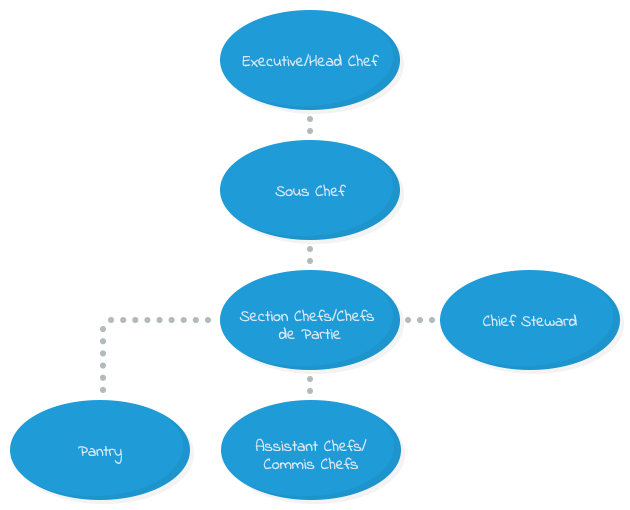Kitchen staff
The number of staff required to support the kitchen operation will depend entirely on the size of the kitchen and the type of dishes that are being prepared. On this page, we will explore staffing requirements for a hotel/restaurant to illustrate this topic (but these requirements will be different in other catering organisations, such as fast-food restaurants or smaller cafés).
Think first
Have you ever heard of the 'partie system' in relation to kitchen operations? What do you think the term 'partie system' means? Have a go at typing a definition into the box below before you move on.
The partie system is used to divide a kitchen area up into different sections. Each section carries out a specific job (or jobs) – for example, preparing or cooking fish, meat, vegetables, desserts, etc.
The number of parties (sections) required, and the number of staff in each, will depend on the size and type of the kitchen operation.
The diagram below shows a staffing structure, which would typically be seen in a hotel or restaurant. Click on each highlighted area to learn more.
Executive/Head Chef
The Executive Chef or Head Chef is in charge of the entire kitchen operation. They have overall responsibility for organising and managing all aspects of the kitchen, including staffing, training, menu planning, finances, food suppliers, etc.
Executive/Head Chefs will usually have spent many years working in a kitchen, perhaps starting out as an Assistant Chef or Commis Chef and working up the chain as they gain experience and take on more responsibility.
The Executive/Head Chef may also have an assistant, to help with paperwork and other administrative tasks.
Sous Chef
Sous is the French word for ‘under’. The Sous Chef supervises menu preparation across all sections/stations in the kitchen. When the Executive/Head Chef is away from the kitchen, the Sous Chef takes charge of the kitchen and the overall supervision of staff, preparation and production.
Large kitchens may have more than one Sous Chef.
Section Chefs/Chefs de Partie
These chefs are in charge of a particular area (or section) of the kitchen. For example, a kitchen may have the following Chefs de Partie:
- Larder Chef (also known as Chef Garde-Manger) – in charge of the cold room, prepares cold foods, including salads, cold starters, pates, etc.
- Sauce Chef (also known as Chef Saucier) – responsible for all aspects of sauce preparation and production, perhaps also warm starters.
- Fish Chef (also known as Chef Poissonnier) – responsible for all aspects of fish preparation and production.
- Grill Chef (also known as Chef Grillardin) – responsible for any foods that must be grilled; this can include meat, fish, poultry and vegetables.
- Vegetable Chef (also known as Chef Legumier) – responsible for all aspects of vegetable preparation and production.
- Pastry Chef (also known as Chef Patissier) – responsible for making all desserts and baked goods, including pastries, cakes, biscuits, chocolates and bread.
Chief Steward
The Chief Steward is in charge of keeping the kitchen clean. A Steward may also work in the kitchen, reporting to the Chief Steward. Other roles in this area may include Kitchen Porter and Pot Washer.
Assistant Chefs/Commis Chefs
Assistant Chefs (or Commis Chefs) are chefs in training, and they support the Chefs de Partie in each section of the kitchen. They will help with particular duties in their assigned section (for example, an assistant vegetable chef will help to wash, peel and trim vegetables).
A kitchen may also employ apprentices and trainees as assistant chefs.
Pantry
The person in charge of the pantry looks after all of the dry goods and stored items.
As you can imagine, any kitchen will require good teamwork and communication in order to operate effectively. It’s important that different sections of the kitchen are able to share information and work well together, so that food can flow through the different processes involved in storing, preparing and producing it for customers. For example, two or more chefs may be involved in preparing different ingredients for a dish (such as fish and vegetables) – they need to be able to communicate with each other so that all of the ingredients are ready at the same time for serving the dish to the customer.
The senior chefs (Head Chef, Sous Chef, etc) must have good leadership and people management skills in order to support and motivate their kitchen staff. If staff are well managed and feel supported and valued, this will contribute to high staff morale which in turn improves the productivity of staff... meaning that customers will receive a high-quality service.

